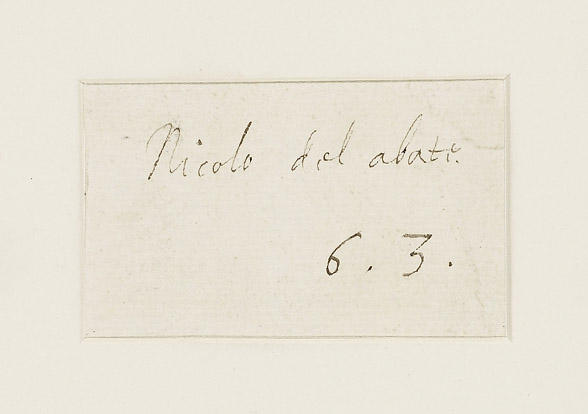St Augustine and St Genevieve c.1560
Pen and brown ink with brown wash and white heightening, over black chalk, on buff paper | 41.5 x 26.5 cm (sheet of paper) | RCIN 990146





-
A drawing of the two saints, standing in a landscape, with a frame drawn around.
Niccolò dell’Abbate worked in his native Modena and nearby Bologna before travelling to France in 1552, where he worked at Fontainebleau as assistant to and collaborator with Francesco Primaticcio. Niccolò undertook important commissions for the French royal family and the court, among them the kings Henry II and Francis II, and Anne de Montmorency, Constable of France.
The present drawing is probably one of the many designs Niccolò made while working with Primaticcio. It shows, to the left, St Augustine, holding his episcopal crosier and a heart (symbol of the penitence expressed in his 'Confessions'), with his mitre held by three putti who sit at the foot of the picture. To the right is St Genevieve, holding a candle which remains alight despite the efforts of a demon, who attempts to extinguish it with his bellows. An angel hovers above to prevent the demon from accomplishing his task. The two saints are framed within a border, half of which is filled with floral and scrolling ornament. Above, an angel supports a shield bearing a heart and crowned with a coronet.
The FM monogram at the bottom right of the frame suggests that this drawing was a preparatory study for a work to be made in honour of Francis II and Mary, Queen of Scots. The young couple used this monogram on coins issued shortly after their marriage in 1558. Although the charges on the shield at top right have not been delineated, the line down the centre may indicate that this is to represent a set of impaled arms, presumably France impaling Scotland. Francis II died in 1560, after only a year on the throne, and given the prominence of the heart on the shield which tops the design, it is possible that the design was made in connection with the plans for Francis’s 'heart monument', destined for the cathedral of Orleans (where he died), but never completed. In this period the hearts of prominent figures were often buried separately from the rest of their corpse, meaning that memorials encouraging remembrance were erected in more than one location. A heart burial was usually associated with a place which bore a special significance to the deceased, either the place of death or birth or a personal foundation. Details of payments for Francis II’s monument survive in the royal building accounts and show that the major craftsmen working for the French crown at the time were involved in its design. An angel by Frémin Roussel (active 1563-70) after Primaticcio survives in the Louvre, and another fragment at Saint-Denis in Paris. The accounts make clear that the monument was to be decorated with putti. An association with a heart monument would also explain the presence of St Augustine, holding a heart, whose role is otherwise less easily explained than that of St Genevieve, one of the patron saints of Paris.
As a design for an element of a heart monument, the drawing can be compared with a design for the heart monument of Francis of Lorraine and Anne d’Este (Musée du Louvre, Paris), attributed to the circle of Primaticcio. This is the same format as the present drawing: a rectangular panel surmounted by hearts (on an urn rather than in a shield) under a coronet. Although the Lorraine design appears to be for sculpture rather than a painted panel, both drawings are clearly for wall-mounted works.
See K. Heard, entry in The Northern Renaissance. Dürer to Holbein, London 2011Provenance
William Gibson (his ascription Nicolo del abate and price mark 6.3., verso); probably acquired by Charles II
-
Medium and techniques
Pen and brown ink with brown wash and white heightening, over black chalk, on buff paper
Measurements
41.5 x 26.5 cm (sheet of paper)
Object type(s)








